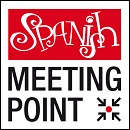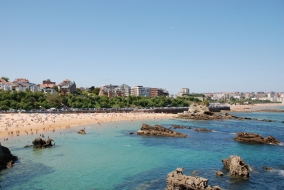Spanish schools and accommodation to study Spanish in Spain
Recent posts
Last schools
introduced
introduced
0 Accommodation

1 Spanish schools

Learning Spanish in Santander. The tourist guide to study your Spanish course.
General Information. 185,000 inhabitants. 450 kilometres north of Madrid. Santander is the capital of the Autonomous Community of Cantabria. It is situated in a large bay that borders the Cantabrian Sea and is surrounded by mountains. Its location, its historic city centre, its wealth of monuments, its seafront gardens, the marina and the Magdalena Peninsula make Santander one of the most important tourist destinations in northern Spain. Santander hosts a large number of conferences and festivals, and tourists can enjoy a wide range of activities all year round, pleasure cruises being just one of the many attractions. The services sector is vital to the city's economy. The first references to Santander date from the year 26 AD. Santander has two public universities, the University of Cantabria, with 12,000 students, and Menéndez Pelayo International University (UIMP), famous for its summer courses which are held at Magdalena Palace, the university's main headquarters. Santander is a very attractive place to study Spanish with many language schools offering a wide range of courses.
Surrounding Areas. Santillana del Mar (30 kilometres), a charming village with its cobblestone streets and medieval houses; the nearby Caves of Altamira, a World Heritage Site. Comillas (54 kilometres), a town which boasts a rich historical heritage and the headquarters of the university that bears its name; San Vicente de la Barquera (60 kilometres), situated on a fortified mound; Castro Urdiales (70 kilometres), with its medieval castle; the Picos de Europa Nature Reserve (Parque Natural de los Picos de Europa) (120 kilometres), with stunning mountain scenery and high-altitude lagoons.
Main Sights. Santander Cathedral and the nearby Plaza Porticada, a porticoed square surrounded by public buildings; Magdalena Palace (1909), which the city of Santander built as a summer holiday residence for the Spanish royal family; the Gran Casino del Sardinero (1916); the Faro del Cabo Mayor, the majestic lighthouse which presides over the entrance to the Bay of Santander; the ‘Small Palace on the Quay' (Palacete del Embarcadero de Santander); the Banco de Santander building.
Culture. The Santander International Festival, organized by the UIMP during the summer period, aims to give university students and tourists the chance to experience Spanish music, folklore and theatre, among a wide range of other cultural events. As for museums, it is worth highlighting the Cantabrian Maritime Museum (Museo Marítimo del Cantábrico), the Municipal Museum of Fine Arts (Museo Municipal de Bellas Artes) and the Santander Bullfighting Museum (Museo Taurino de Santander). The most important performance venues are the Cantabria Festival Palace and the Caja Cantabria Cultural Centre.
Playas. Santander's 12 beaches are a major attraction for tourists and include the 200-metre long Los Peligros, Playa de la Magdalena, and the first (Primera) and second (Segunda) beaches of El Sardinero, the longest and most popular of all, with their seafront promenades.The beaches are a major attraction for the many students who decide to study Spanish in Santander.
Shopping. The widest selection of shops can be found in the city centre, but the El Corte Inglés department store and the Q.O. Peñacastillo and Bahía de Santander malls also offer ample shopping opportunities. There are also several street markets, such as the Mercado de los Hippies, every weekend on the Paseo de San Francisco, the Mercado de México on Calle Alta, and the Mercado de la Esperanza, a good place to buy typical local products.
Gastronomy. There are various gastronomic areas in Santander: in the city centre, the streets to head for are Río de la Pila, Marcelino Sanz de Sautuola, Calle Santa Lucía, El Paseo de Pereda, Puerto Chico and Casimiro Sáinz; the Barrio Pesquero and Calle Tetuán, with good fish and seafood; the Calle Vargas and San Fernando area; and Plaza de Cañadío, which has a great atmosphere and is a popular starting point for a night out. Santander's gastronomy is based on fish and seafood, such as clams, tuna, bocartes (fresh anchovies) and sea bass. Typical dishes include rabas (deep-fried bread-coated squid) cocido montañés, a hearty haricot bean stew with chorizo, black pudding and cabbage. Cantabria also produces some good cheeses with Designation of Origin.
Sport. Racing de Santander is the city's football team. They are currently in the first division and play their home games at the Campos Sport stadium, also known as El Sardinero because of the area where it is located. The city's main sporting facilities include the La Albericia Sports Complex (Complejo Deportivo de la Albericia) the Príncipe Felipe High Performance Centre of Sailing (Centro de Alto Rendimiento de Vela Príncipe Felipe), the Puertochico marina, Mataleñas Golf Course and the Royal Society of Tennis of La Magdalena (Sociedad Real de Tenis de la Magdalena). One of the most popular sporting pastimes is bolos, a form of skittles. Nautical sports also have a long tradition in Santander, especially rowing and the famous regattas.
Fiestas. The most important fiesta is the Semana Grande or ‘Big Week' (second fortnight of July), with many festivities, concerts and cultural activities, followed at the end of August by the Fiestas of the Holy Martyrs Saint Emeterius and Saint Celedonius (Las Fiestas de los Santos Mártires San Emeterio y San Celedonio), who are the patron saints of Santander, and the Fiestas de la Virgen de la Bien Aparecida, the patron saint of Cantabria (15th September).
Transport. A tourist bus route with eight stops takes in all the most emblematic city sights. The tour lasts 1 hour and 45 minutes and the service operates from 1st July to 15th October. It is easy to get from Santander to other Spanish cities by train or by using the various coach services.
Nightlife. Students who decide to study Spanish in Santander will discover a very active nightlife. There are three main nightlife areas: the city centre, in an area bordered by Calle Hernán Cortes, Daoiz, Velarde and Santa Lucía, where you will find Plaza de Cañadío, a traditional place to meet for the first drinks of the evening; the area around Calle Vargas and Calle San Fernando, which is much quieter and more suited to starting with wine and tapas; and El Sardinero, a neighbourhood with a wide range of pubs and disco-bars. It is also worth mentioning the Gran Casino, with its gaming rooms.
Surrounding Areas. Santillana del Mar (30 kilometres), a charming village with its cobblestone streets and medieval houses; the nearby Caves of Altamira, a World Heritage Site. Comillas (54 kilometres), a town which boasts a rich historical heritage and the headquarters of the university that bears its name; San Vicente de la Barquera (60 kilometres), situated on a fortified mound; Castro Urdiales (70 kilometres), with its medieval castle; the Picos de Europa Nature Reserve (Parque Natural de los Picos de Europa) (120 kilometres), with stunning mountain scenery and high-altitude lagoons.
Main Sights. Santander Cathedral and the nearby Plaza Porticada, a porticoed square surrounded by public buildings; Magdalena Palace (1909), which the city of Santander built as a summer holiday residence for the Spanish royal family; the Gran Casino del Sardinero (1916); the Faro del Cabo Mayor, the majestic lighthouse which presides over the entrance to the Bay of Santander; the ‘Small Palace on the Quay' (Palacete del Embarcadero de Santander); the Banco de Santander building.
Culture. The Santander International Festival, organized by the UIMP during the summer period, aims to give university students and tourists the chance to experience Spanish music, folklore and theatre, among a wide range of other cultural events. As for museums, it is worth highlighting the Cantabrian Maritime Museum (Museo Marítimo del Cantábrico), the Municipal Museum of Fine Arts (Museo Municipal de Bellas Artes) and the Santander Bullfighting Museum (Museo Taurino de Santander). The most important performance venues are the Cantabria Festival Palace and the Caja Cantabria Cultural Centre.
Playas. Santander's 12 beaches are a major attraction for tourists and include the 200-metre long Los Peligros, Playa de la Magdalena, and the first (Primera) and second (Segunda) beaches of El Sardinero, the longest and most popular of all, with their seafront promenades.The beaches are a major attraction for the many students who decide to study Spanish in Santander.
Shopping. The widest selection of shops can be found in the city centre, but the El Corte Inglés department store and the Q.O. Peñacastillo and Bahía de Santander malls also offer ample shopping opportunities. There are also several street markets, such as the Mercado de los Hippies, every weekend on the Paseo de San Francisco, the Mercado de México on Calle Alta, and the Mercado de la Esperanza, a good place to buy typical local products.
Gastronomy. There are various gastronomic areas in Santander: in the city centre, the streets to head for are Río de la Pila, Marcelino Sanz de Sautuola, Calle Santa Lucía, El Paseo de Pereda, Puerto Chico and Casimiro Sáinz; the Barrio Pesquero and Calle Tetuán, with good fish and seafood; the Calle Vargas and San Fernando area; and Plaza de Cañadío, which has a great atmosphere and is a popular starting point for a night out. Santander's gastronomy is based on fish and seafood, such as clams, tuna, bocartes (fresh anchovies) and sea bass. Typical dishes include rabas (deep-fried bread-coated squid) cocido montañés, a hearty haricot bean stew with chorizo, black pudding and cabbage. Cantabria also produces some good cheeses with Designation of Origin.
Sport. Racing de Santander is the city's football team. They are currently in the first division and play their home games at the Campos Sport stadium, also known as El Sardinero because of the area where it is located. The city's main sporting facilities include the La Albericia Sports Complex (Complejo Deportivo de la Albericia) the Príncipe Felipe High Performance Centre of Sailing (Centro de Alto Rendimiento de Vela Príncipe Felipe), the Puertochico marina, Mataleñas Golf Course and the Royal Society of Tennis of La Magdalena (Sociedad Real de Tenis de la Magdalena). One of the most popular sporting pastimes is bolos, a form of skittles. Nautical sports also have a long tradition in Santander, especially rowing and the famous regattas.
Fiestas. The most important fiesta is the Semana Grande or ‘Big Week' (second fortnight of July), with many festivities, concerts and cultural activities, followed at the end of August by the Fiestas of the Holy Martyrs Saint Emeterius and Saint Celedonius (Las Fiestas de los Santos Mártires San Emeterio y San Celedonio), who are the patron saints of Santander, and the Fiestas de la Virgen de la Bien Aparecida, the patron saint of Cantabria (15th September).
Transport. A tourist bus route with eight stops takes in all the most emblematic city sights. The tour lasts 1 hour and 45 minutes and the service operates from 1st July to 15th October. It is easy to get from Santander to other Spanish cities by train or by using the various coach services.
Nightlife. Students who decide to study Spanish in Santander will discover a very active nightlife. There are three main nightlife areas: the city centre, in an area bordered by Calle Hernán Cortes, Daoiz, Velarde and Santa Lucía, where you will find Plaza de Cañadío, a traditional place to meet for the first drinks of the evening; the area around Calle Vargas and Calle San Fernando, which is much quieter and more suited to starting with wine and tapas; and El Sardinero, a neighbourhood with a wide range of pubs and disco-bars. It is also worth mentioning the Gran Casino, with its gaming rooms.
© TEXT: SPANISH IN TOUR.
VIDEO: Patronato de Turismo de Cantabria
VIDEO: Patronato de Turismo de Cantabria






















_68-viajar24h-30_04_081722.jpg)
_27-viajar24h-30_04_081723.jpg)